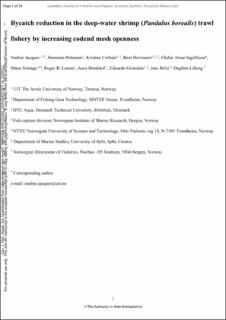| dc.contributor.author | Jacques, Nadine | |
| dc.contributor.author | Pettersen, Hermann | |
| dc.contributor.author | Cerbule, Kristine | |
| dc.contributor.author | Herrmann, Bent | |
| dc.contributor.author | Ingólfsson, Ólafur Arnar | |
| dc.contributor.author | Sistiaga, Manu Berrondo | |
| dc.contributor.author | Larsen, Roger B. | |
| dc.contributor.author | Brinkhof, Jesse | |
| dc.contributor.author | Grimaldo, Vela Eduardo | |
| dc.contributor.author | Brčić, Jure | |
| dc.contributor.author | Lilleng, Dagfinn | |
| dc.date.accessioned | 2022-01-19T14:38:51Z | |
| dc.date.available | 2022-01-19T14:38:51Z | |
| dc.date.created | 2021-09-08T10:20:55Z | |
| dc.date.issued | 2021 | |
| dc.identifier.citation | Canadian Journal of Fisheries and Aquatic Sciences. 2021, . | |
| dc.identifier.issn | 0706-652X | |
| dc.identifier.uri | https://hdl.handle.net/11250/2838334 | |
| dc.description.abstract | In most trawl fisheries, drag forces tend to close the meshes in large areas of diamond mesh codends, negatively affecting their selective potential. In the Barents Sea deep-water shrimp (Pandalus borealis) trawl fishery, selectivity is based on a sorting grid followed by a diamond mesh codend. However, the retention of juvenile fish as well as undersized shrimp is still a problem. In this study, we estimated the effect of applying different codend modifications, each aimed at affecting codend mesh openness and thereby selectivity. Changing from a 4-panel to a 2-panel construction of the codend did not affect size selectivity. Shortening the lastridge ropes of a 4-panel codend by 20% resulted in minor reductions for juvenile fish bycatch, but a 45% reduction of undersized shrimp was observed. Target-size catches of shrimp were nearly unaffected. When the codend mesh circumference was reduced while simultaneously shortening the lastridge ropes, the effect on catch efficiency for shrimp or juvenile fish bycatch was marginal compared to a 4-panel codend design with shortened lastridge ropes. | |
| dc.language.iso | eng | |
| dc.title | Bycatch reduction in the deep-water shrimp (Pandalus borealis) trawl fishery by increasing codend mesh openness | |
| dc.type | Peer reviewed | |
| dc.type | Journal article | |
| dc.description.version | acceptedVersion | |
| dc.description.version | publishedVersion | |
| dc.source.pagenumber | 34 | |
| dc.source.journal | Canadian Journal of Fisheries and Aquatic Sciences | |
| dc.identifier.doi | 10.1139/cjfas-2021-0045 | |
| dc.identifier.cristin | 1932314 | |
| dc.relation.project | Fiskeri- og havbruksnæringens forskningsfinansiering: 901303 | |
| cristin.ispublished | true | |
| cristin.fulltext | postprint | |
| cristin.fulltext | original | |
| cristin.qualitycode | 2 | |

